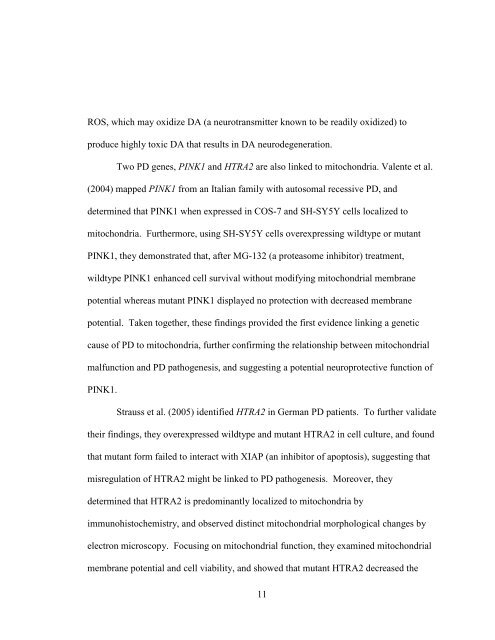identification of neuroprotective genes against alpha - acumen - The ...
identification of neuroprotective genes against alpha - acumen - The ...
identification of neuroprotective genes against alpha - acumen - The ...
Create successful ePaper yourself
Turn your PDF publications into a flip-book with our unique Google optimized e-Paper software.
ROS, which may oxidize DA (a neurotransmitter known to be readily oxidized) to<br />
produce highly toxic DA that results in DA neurodegeneration.<br />
Two PD <strong>genes</strong>, PINK1 and HTRA2 are also linked to mitochondria. Valente et al.<br />
(2004) mapped PINK1 from an Italian family with autosomal recessive PD, and<br />
determined that PINK1 when expressed in COS-7 and SH-SY5Y cells localized to<br />
mitochondria. Furthermore, using SH-SY5Y cells overexpressing wildtype or mutant<br />
PINK1, they demonstrated that, after MG-132 (a proteasome inhibitor) treatment,<br />
wildtype PINK1 enhanced cell survival without modifying mitochondrial membrane<br />
potential whereas mutant PINK1 displayed no protection with decreased membrane<br />
potential. Taken together, these findings provided the first evidence linking a genetic<br />
cause <strong>of</strong> PD to mitochondria, further confirming the relationship between mitochondrial<br />
malfunction and PD patho<strong>genes</strong>is, and suggesting a potential <strong>neuroprotective</strong> function <strong>of</strong><br />
PINK1.<br />
Strauss et al. (2005) identified HTRA2 in German PD patients. To further validate<br />
their findings, they overexpressed wildtype and mutant HTRA2 in cell culture, and found<br />
that mutant form failed to interact with XIAP (an inhibitor <strong>of</strong> apoptosis), suggesting that<br />
misregulation <strong>of</strong> HTRA2 might be linked to PD patho<strong>genes</strong>is. Moreover, they<br />
determined that HTRA2 is predominantly localized to mitochondria by<br />
immunohistochemistry, and observed distinct mitochondrial morphological changes by<br />
electron microscopy. Focusing on mitochondrial function, they examined mitochondrial<br />
membrane potential and cell viability, and showed that mutant HTRA2 decreased the<br />
11

















